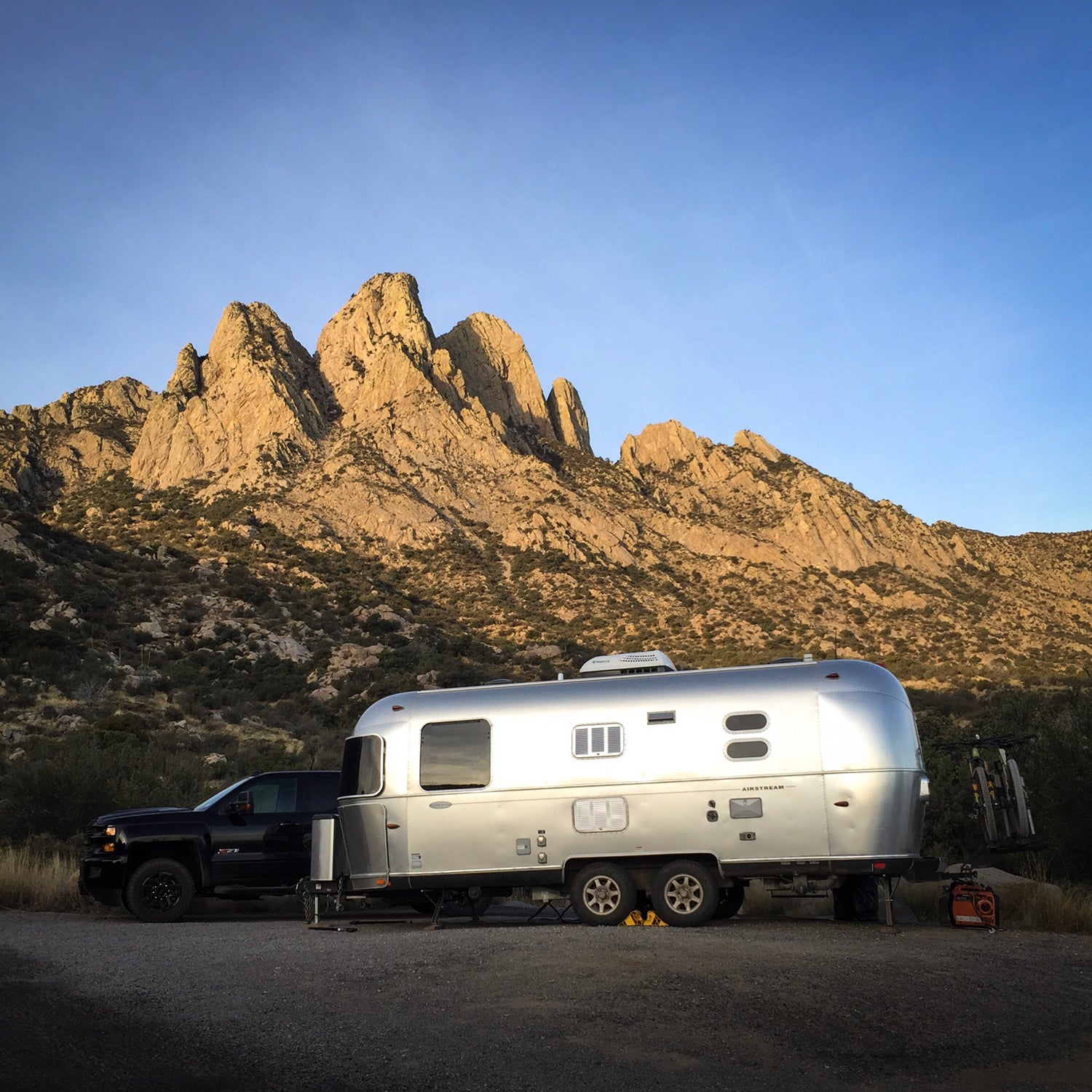When official word came last month that the Trump Administration had decided to and revise the management and use designations on six more, our loose itinerary with Artemis the Airstream for the next few months suddenly got a little clearer. We would try to see as much of these lands as we could before they lost their protections. 
It feels like perhaps our most important job in this debate over the monuments and public lands is to get out and use them. To that end, my wife, Jen, and I were in luck. A number of the contested monuments, including BearÔÇÖs Ears and Grand Staircase Escalante in Utah, Gold Butte in Nevada, are within striking distance of our home in Santa Fe. There are even two in┬áNew Mexico that are set for revisions: Rio Grande del Norte, where we camped a week last fall, and Organ Mountains-Desert Peaks, near the Texas border. Since we were already on a southward trajectory to visit , we diverted west toward the Organs.
Jen and I were┬áfamiliar with the area after planning┬ádozens of winter mountain biking trips to the Do├▒a Ana Mountains, northeast of Las Cruces, New Mexico. But the of singletrack┬áwe'd ridden in these parched hills touches on only a tiny fraction of the monument. Designated by President Barack Obama on , this sprawling, almost 500,000-acre preserve┬áencompasses five mountain rangesÔÇöthe Do├▒a Anas, Robledos, Sierra de Las Uvas, Potrillos, and OrgansÔÇöthat encircle the main town like a jagged, stony ring. This time, we headed for the Organs, where the parkÔÇÖs primary campground, , crouches on the crenellated eastern slopes. We were nervous that we might not get a space at the campground, but at the gate, the hosts seemed almost thrilled to see us. ÔÇťWe have 55 sites up there and only two or three campers right now. We tend to get a little forgotten,ÔÇŁ one of them told us. ÔÇťStay as long as you like.ÔÇŁ
Jen and I normally opt for backcountry camps instead of formal campgrounds, but Aguirre Springs feels wild, with basic pad sites tucked beneath stands of wiry juniper and mountain mahogany. Even getting there felt adventurous, as the road climbs 800 feet on pavement so sinuous that itÔÇÖs not recommended for trailers over 23 feet. It closes┬áafter dark to prevent car crashes. ThereÔÇÖs no overview map available, and trails arenÔÇÖt always marked or well maintained. At the visitor center, the only information comes from a haphazard and pretty rudimentary assortment of single-sided handouts. Organ Mountains comes off as a place recently designated and not terribly well funded.
ÔÇťItÔÇÖs a lot of land out here,ÔÇŁ said one of the visitor center employees, who asked that I not use his name. ÔÇťAnd though weÔÇÖre supposed to maintain and protect it, the government just keeps cutting our budgets.ÔÇŁ I asked him what the recent announcement about the monuments would mean for Organ Mountains. ÔÇťSearch me,ÔÇŁ he said. ÔÇťSeems like weÔÇÖre the last to know.ÔÇŁ
Some people might look at Organ Mountains and see a desolate, brutal place with impoverished infrastructure and little redeeming value. But the feral nature of the place is part of its charm. Our wilderness┬áareas and national monuments┬áshouldn't be┬ácharted out and paved over. Having places like this where we can wander scraggly paths and find our own adventures and get lost for days┬áis good for the soul. And the breadth of open land that has been preserved here is a major part of its appeal. Over the course of a week, we encountered only┬ávery few people and, when we ventured into the backcountry, we┬ácould look to the horizon and see nothing but empty desert. There are no current plans to parcel up this country or open it up to new extraction, as is the case in other embattled monuments. But the lesson hereÔÇöthat some of the value lies in the totality of the land and the breadth and integrity of the wild spaceÔÇöshould give us pause when it comes to figuring out management plans elsewhere.┬á
On our last day, we hiked the Organ Needle, a serrated finger of granite thatÔÇÖs one of the rangeÔÇÖs most foreboding and spectacular features. We found little information┬áabout the hike except for a few random Strava tracks and a vague description that it was ÔÇťsomewhat steep.ÔÇŁ After a mile of walking flats covered with prickly pear and ocotillo, the trail clambered straight up on a loose, scree-covered track that even mountain goats might find tricky. Snow slicked the summit gully, and a length of climbing rope hung as vague protection for the exposed rock moves to the peak. It was more strenuous and committing of an ascent than weÔÇÖd imaginedÔÇöand more rewarding because of it. On top, we signed the summit register, the first people to do so in over a week. In some small way, it felt like adding our names to a petition for the importance of such lonely places.


